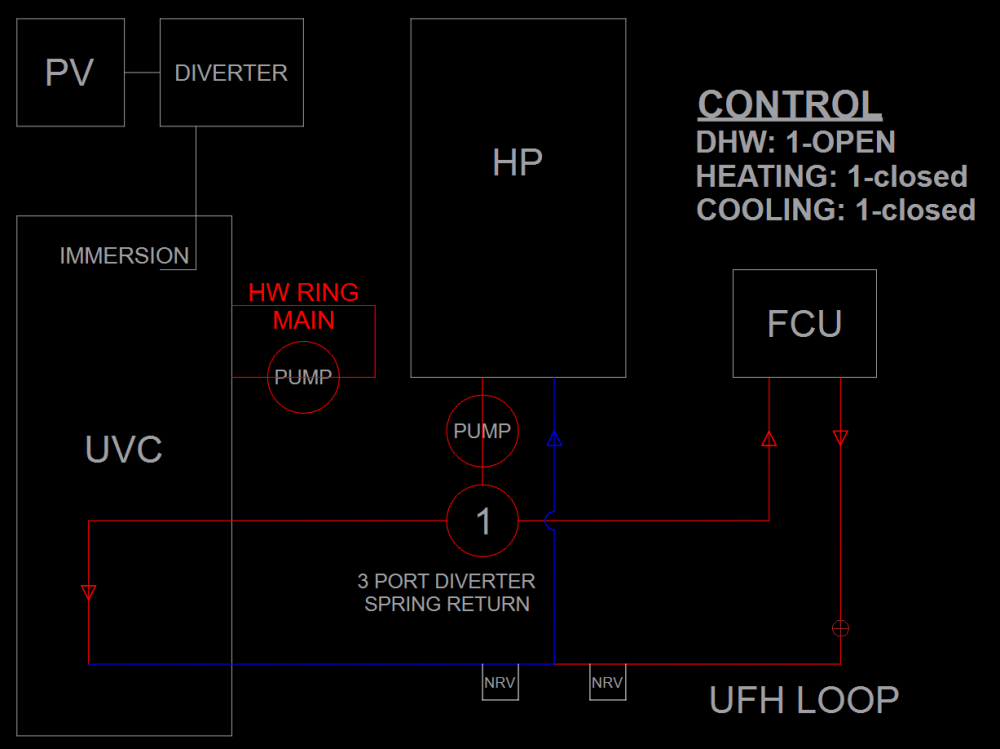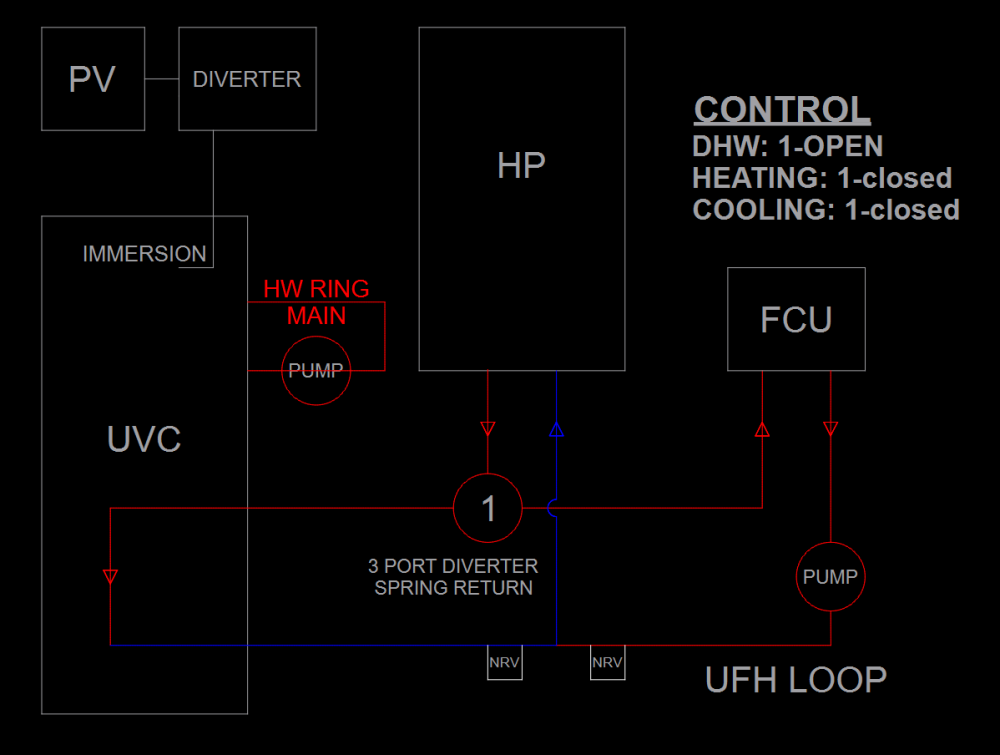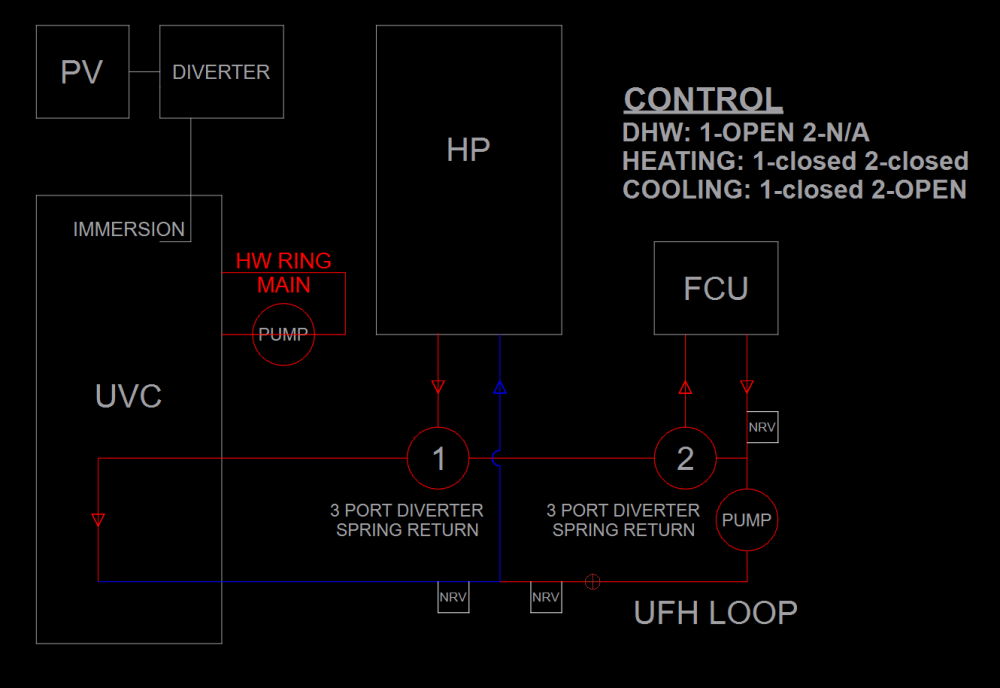
Duncan62
Members-
Posts
175 -
Joined
-
Last visited
Recent Profile Visitors
The recent visitors block is disabled and is not being shown to other users.
Duncan62's Achievements

Regular Member (4/5)
34
Reputation
-
maybe using this, in reverse, would passively do the trick. https://esbe.eu/group/products/thermostatic-mixing-valves/vta370-vta570 mix output on valve as input from HP. set to 20 deg. if 25deg input from HP, then cold will open and hot will close. thus cold output goes out to UFH. if 15deg input from HP, then the hot will open and cold will close. thus hot goes out to the fan coil unit. (and only £80)
-
Only issue I see there is that it's not a diverter, the MBA is only on/off for a single pipe.
-
It would try to mix flows yes. My thinking is if I ask it to mix to a max of 20, at 20 or above it will fully open with cold too try to mix down to 20. But that won't happen as the heart pump controls the temp. Similar in reverse for cooling water. Mixer had a look temp of 18 so at 18 or below, it will be fully open with hot to try to mix the temp higher. Hence in each case, the UFH comes off the cold outlet. The FCU comes off the hot outlet. Temp controlled by the heat pump. Cooling called for via software from the sensor in the landing.
-
Hello BH, another wacky question for discussion. I would like a Thermal Diverter Valve (TDV) in my setup, to send cold water through the FCU in summer, but hot water to the UFH in winter. I would like this TDV to be self regulating, so that I can set and forget. My thought is to use a Change-over/Diverting valve with a constant temperature Controller. I would use the valve in reverse essentially. If I set the controller to a MAX of 20deg, the hot water for the UFH at more than 20deg will close the HOT outlet of the valve and open the COLD outlet - this is sent to the UFH. If I set the controller to a MIN of 18deg, the cold water for the FCU at less than 18deg will close the COLD outlet of the valve and open the HOT outlet - this is sent to the FCU. Change-over/Diverting valve: https://esbe.eu/group/products/rotary-valves/vrg230 Constant temperature Controller: https://www.esbe.eu/group/products/controllers/cra200 comments?
-
I would highly recommend doing it yourself if you have the time and inclination. I did all our planning drawings and PHPP. The cost, as said, it time. But compared to the quoted costs, seems like a bargain. Takes a long time to earn £20k after tax too. No one will care about it as much as you. Id say consider Passivhaus certification. As a proportion of total cost it is low, Circa £2.5k AND the initial design reviews will correct any errors and guide you in the right direction.
- 9 replies
-
- 1
-

-
- passivhaus
- technical
-
(and 1 more)
Tagged with:
-
Integrated or Non Integrated, that is the question?
Duncan62 replied to Duncan62's topic in Air Source Heat Pumps (ASHP)
Yes the control center is inside the pump. Guess I'd need to wire a connection from there to the diverter inside. So no saving on envelope penetrations. It has to be aesthetically appealing. Almost none are. -
Integrated or Non Integrated, that is the question?
Duncan62 replied to Duncan62's topic in Air Source Heat Pumps (ASHP)
Great stuff. How is the three port diverter activated? With the non integrated, the control box is inside and a wire goes to the three port diverter to activate it as required. -
Integrated or Non Integrated, that is the question?
Duncan62 replied to Duncan62's topic in Air Source Heat Pumps (ASHP)
They are in the physical unit outside. Footprint is slightly larger. But you free up space inside. -
Hello Guidance please on should I be getting an Integrated or Non integrated Heat pump? Samsung Gen 7 is my choice, links to each above. Integrated inc: Primary Pump - UPM4K25-75/130 Samsung Flow Sensor Control Centre EHS Wifi Kit Expansion Vessel - 10L, 0.3 MPa working pressure Water pressure sensor Gas seperator air vent Strainer 2.9 bar pressure relief valve Non integrated omits all this. Does the included expansion vessel mean I don't need one inside next to the DHW cylinder? Pros: means it frees up space inside the plant room, no controller and other items. wireless controller (presumably with the temp sensor) can be moved to optimal central hose location no holes through my precious air tightness layer for control cables cons: does the wifi have to be up, always, for it to work? not the end of the world but worth knowing.
-
Simple is best. Samsung Gen 7 heat pump comes without a circulation pump. Thus 1 pump in plant room. Direct system one zone.
-
THOUGHT: Can the normal heat pump controller and associated house thermostat be used to call for cooling too? Then it can run the cooling water automatically? Id then simply need to turn on the fan coil fan, which is easy.
-
Simplest Solution - Spring return 3 Port Diverter. Heating water travels via FCU in 22mm pipe before UFH manifold. Bypass FCU option - Same as above but FCU is bypassed in UFH use
-
Yes, 5kW heat pump. 22mm make sense if running in series with UFH. Will need insulating. will be quire large to feed through walls.
-
This is a very good point, I was going to run 15mm to the fan coil, but should probably use 22mm? FCU is large, so will run above due point to avoid issues, should still provide adequate cooling.
-
1. In this case how do I call for cooling? And what will turn on and modulate the fan coil fans? (I agree if heating either DHW or UFH, this is all sorted in the HP control box an wired controller, its adding cooling and controlling that that is difficult) 2. Excellent, as depicted below (removal of powered valve/switch) 3. Trox PWX 120-2. 5 outlets = 4 bedrooms + living room https://www.troxuk.co.uk/fancoil-units/pwx-ea11f88aee974359





